If you wear workbooks regularly and experience foot discomfort, it might be time to invest in some new work boot insoles. Maybe the stock insoles just don’t provide that out-of-box comfort you expect from your work boots.
Or maybe your work boots’ cushioning has compressed and you’ll no longer get the level of comfort you once had. Even if your work boots don’t show outwardly visible signs of wear-and-tear like like holes or a worn down tread, they still may cause pain. The good news is that you can extend the life of boots by buying great insoles.
But how do you know what are the best insoles for work boots?
We’ve put together everything you need to choose the perfect insole for work boots and a list of insoles that will make your work boots more comfortable. We’ll start by identifying what makes the best insoles for work boots, then we’ll talk about identifying common foot problems and then we’ve got a list of the best insoles to solve your specific foot issue.
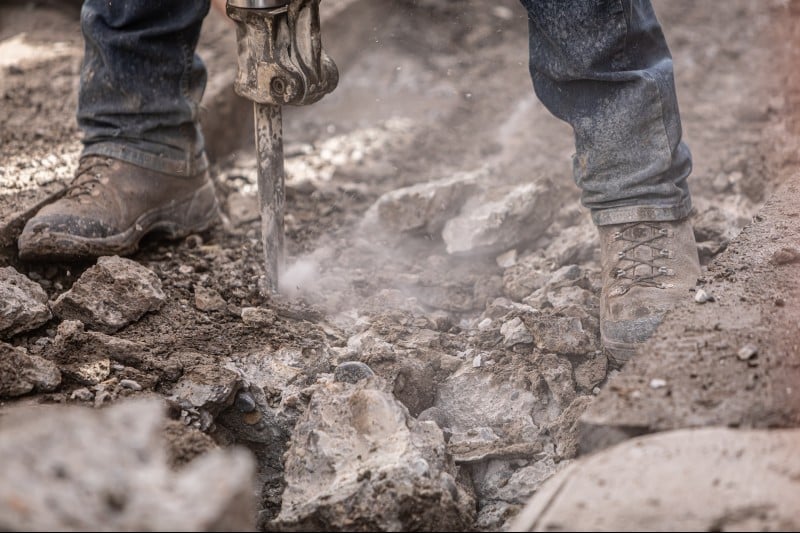
Overview: What makes good work boot insole?
Before investing in a new pair of work boot insoles, you want to make sure you know your size, what foot problems you want to solve, and what type of insole you want to buy. This can be more difficult than you might think. There are tons of different work boot insoles that solve a wide range of problems.
Sizing
You’ll want to check if the insoles you want are one-size insoles that need to be cut, or individual sizes. It’s pretty easy to trim your insoles, but a pair can go for up to $100, so you really don’t want to mess it up.
If your boots have removable insoles, just use them as a template to measure and cut your new insoles.

Anti-fatigue
Anti-fatigue insoles are found in insoles act like your personal anti-fatigue mat used for people who stand for long hours. These absorb shock and return energy to your feet as you walk. Most anti-fatigue insoles contain a material that will rebound as you walk or will provide cushioning similar to personal anti-fatigue mat found in shops and factories where you may stand for long hours.
Arch Support
Arch support is one of the key features of any insoles. Knowing what kind of arch you have is a prerequisite to buying a functional pair of insoles. If you get it wrong, the insole may cause more pain and discomfort at work.
People with high arches need more stability and want rigid plastic support under the arch, people with medium arches or flexible flat arches need medium arch support and stability, people with rigid flat feet should buy insoles for low arches avoid ‘molded arches’ as they will press into the bottom of your foot.
Finding the perfect insole for your arch can be very difficult. Fortunately, brands like SuperFeet make it easy to find which insole works best with your arch shape. Most insoles manufactures like SuperFeet, Dr. Scholls, and TreadLab have insoles designed for multiple arch heights.
We have a guide here, so if you want to check what kind of arch you have, give it a go. You might be surprised.
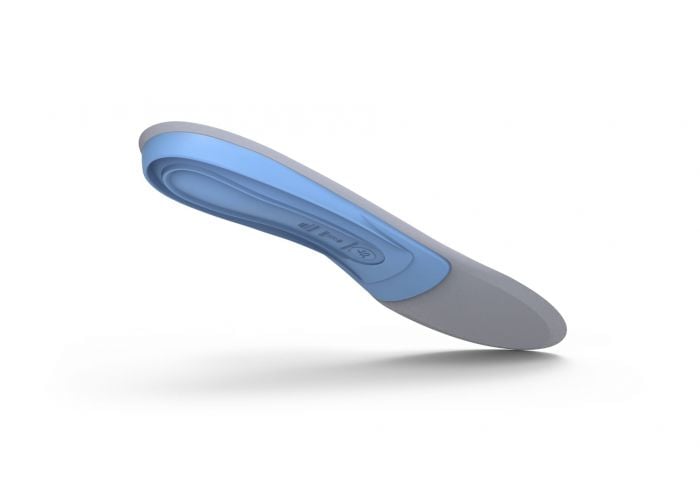
Materials and durability
Choosing which materials you need for your insoles is no simple task. There are tons of options like leather, memory foam, EVA, and combinations of these materials. The type of material is largely based on what type of work you do and what type of foot you have. Other factors include your body weight and medical history.
Typically, the softer or squishier the material the faster it will compress and wear out. Brands like SuperFeet say that their high-density foam lasts for about 500 miles of usage.
Dimensions and Volume
Choosing the right dimensions for your insoles is very important. The length and width can be trimmed but the overall volume of your work boot insole can transform the fit of your work boot, resulting in a too tight fit. When you start stacking molded plastic, cushioning, and other materials, the insoles quickly take up a lot more room in a pair of boots, if you wear thick socks in the winter, your boots may not fit anymore.
Some brands like Tread Labs have thin insoles that work well if you don’t have a lot of extra space in your worked, or you need to wear thick socks in the winter.
Shock absorbing design
Insoles absorb shock and cushion your feet as you walk or stand. It’s especially important to have shock absorption in the heel of your insoles. Timberland’s Pro Anti-fatigue insoles provide cushioning material in the heel strike area.

Common Foot Problems
Finding the best insoles for work boots will depend on which of these issues you trying to fix.
There are a few common foot problems you may experience from working long hours and wearing work boots. These problems are caused by poorly fitting boots, the shape of our feet, injuries, your body type, or the type of work you do.
- High arches & Instability. High arches cause a lot of problems because they can cause instability because of pronation and functional ankle instability (FAI). A study has shown that full-length, semirigid orthotics manufactured with a urethane base and an ethylene vinyl acetate top cover worked well to improve stability.
- Flat feet & Over-pronation. If you have a flexible flat foot, you’re encouraged to buy a structured insole that has foams like EVA or Poron.
- Plantar fasciitis & heel spurs. Look for an insole with a cupped heel and arch support.
- Metatarsalgia. Purchase a full length insole with lots of gel cushioning in the forefoot.
Over-pronation happens when your foot rolls too far inward when you take a step. It’s common with people with flat, flexible arches, but can also occur with people with high-arches as well. If you suffer from both, try Powerstep’s Pinnacle Maxx Insoles, since they are designed for this specific use case.
Over-pronation can cause plantar fasciitis. If you over pronate, your work boot insoles should have a deep heel cup to force your feet into a more natural alignment, and a semi-rigid shell with arch support that provides stability.
Plantar fasciitis is pain in your heel, especially when standing up after resting. It’s often an overuse injury and very common with people who are on their feet every day for work. You’ll know you have it if the surface of your sole (plantar) around the arch hurts when you wake up or after you rested.

A heel spur is a bone growth on the heel bone, usually underneath the heel bone. Your heel works as a shock absorber as you walk during work. If the plantar fascia is overused from carrying heavy boxes, wearing poorly fitting shoes or walking too much while overweight. These activities cause stress and inflammation of the tissue pulling on the bone. Over time, the body builds extra bone in response to this work related stress.
If you have heel spurs, you can get short cushioned heels, but there is a strong correlation between people with heel spurs and plantar fasciitis and will benefit from full length inserts.
Pain in the ball of the foot, or on the bottom of the foot behind the toes, may be caused by nerve or joint damage in that area is often called metatarsalgia. Much like the other problems cushioning and shock absorption are must-have features. You may like a pair of Dr Scholl’s massaging gel line.
Fortunately, plantar fasciitis, heel spurs and pain the in ball of your foot have similar fixes. You’ll want to buy insoles that have a raised or padded heel which protects your heel from extra impact or pressure. Some may feature a deep heel which is fine as long as there is enough cushioning between the heel and the ground. Materials that mold to your foot are also beneficial if you have heel spurs. Basically, buy insoles with cushioning, lots and lots of cushioning and shock absorption.
The Achilles tendon is another common problem area for people who are on their feet working for long hours. You’ll experience inflammation of the tendon due to overuse. The supportive, heel-hugging shape of insoles like Superfeet and TreadLabs may help reduce stress and tension on the Achilles tendon. If you have plantar fasciitis, tightness in the Achilles tendon is found in almost 80% of cases.
The best insoles for work boots will provide plenty of cushioning to take the pressure off of your feet, will help align your body to a more natural position, and take pressure of your tendons.
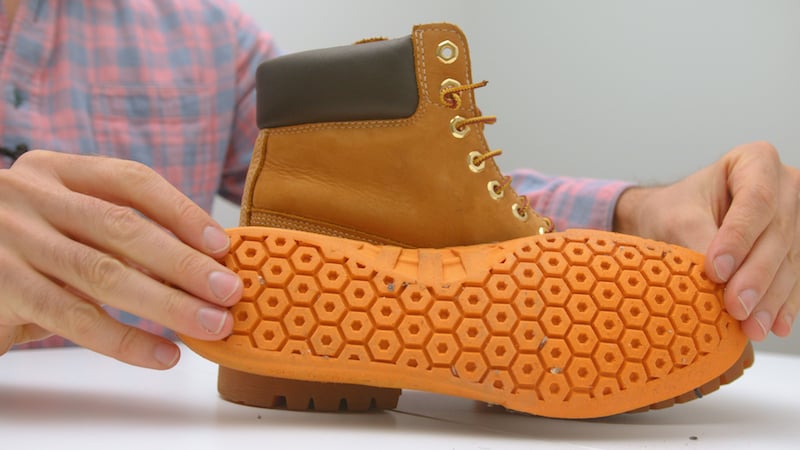
Different Types of Work Boot Insoles
- Rigid orthotic arch support insoles are helpful if your foot, ankles, knees, and hips move abnormally while walking. People with high arches often suffer from these problems due to instability. Check out SuperFeet Green for high arches.
- Semi-rigid orthotic support is best if you stand all day at work, have low arches or over-pronate.
- Cushioned arch support provide cushioning for sore spots caused plantar fasciitis or diabetic foot ulcers and also provide some arch support. The SuperFeet Copper is a cushioned insole that provides medium arch support.
- No arch support/flat cushion these are best for people looking for additional comfort, and have rigid flat feet. The Spenco Heavy Duty are a good bet if your feet fall into the is category.
One important thing to keep in mind is whether you should get off-the-shelf insoles like Superfeet or Dr. Scholls: go to a kiosk and get scanned, or see a podiatrist and have a custom insole made. Feet are extremely complicated, and the number of factors needed to keep your feet comfy during work can seem overwhelming.
What’s The Difference Between Custom vs. Off-the-shelf work boot insoles?
There are generally two different insoles. You can buy off-the-self insoles, which we’re talking about here. There are also custom molded orthotic insoles that you get from the doctor.
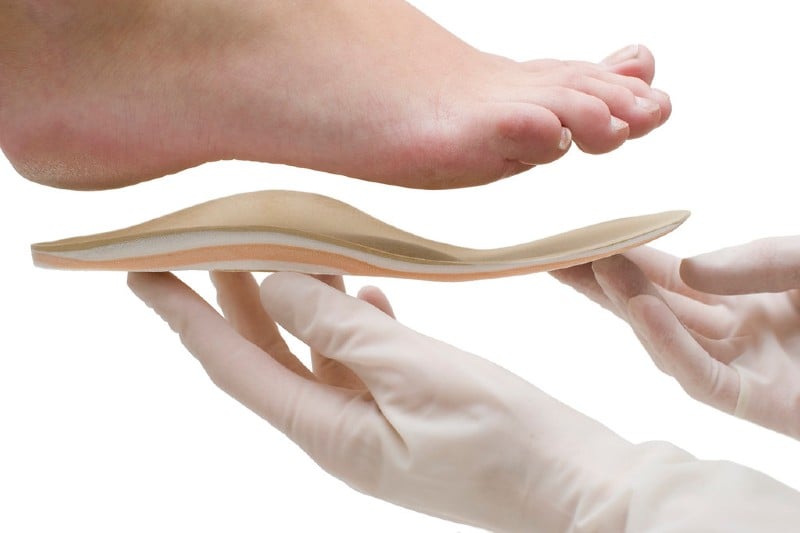
Types of off-the-shelf insoles for work boots
There is an unbelievable selection of off-the-shelf insoles for boots.
You can buy heat-moldable insoles like SuperFeet’s Custom Carbon All Season insoles, but you’ll need to go to a store as these often require special ovens. They aren’t available online.
There are full length insoles and specific insoles for people with different arch shapes. One of the difficult things about buying insoles is there’s so many marketing terms that understanding what you’re even buying may be difficult, plus many insoles treat the similar problems but may differ in small yet important ways like the type of molded arch.
What type of insole should you get for work boots?
Guys with an average weight, height, and foot type usually do fine with over-the-counter insoles for their work boots. They are less expensive and usually decrease pain and discomfort. However, you may have to replace them more often. Someone with a specific need or a problem such as a severely flat foot or very high arch may benefit from custom prescription orthotics.
It’s important to know what kind of foot shape you have before buying insoles for your work boots, because it can be very uncomfortable, expensive and counterproductive to get a wrong type.
Anti microbial footbeds are a good idea because spending 8 hours + in work boots means your insoles may get stinky.
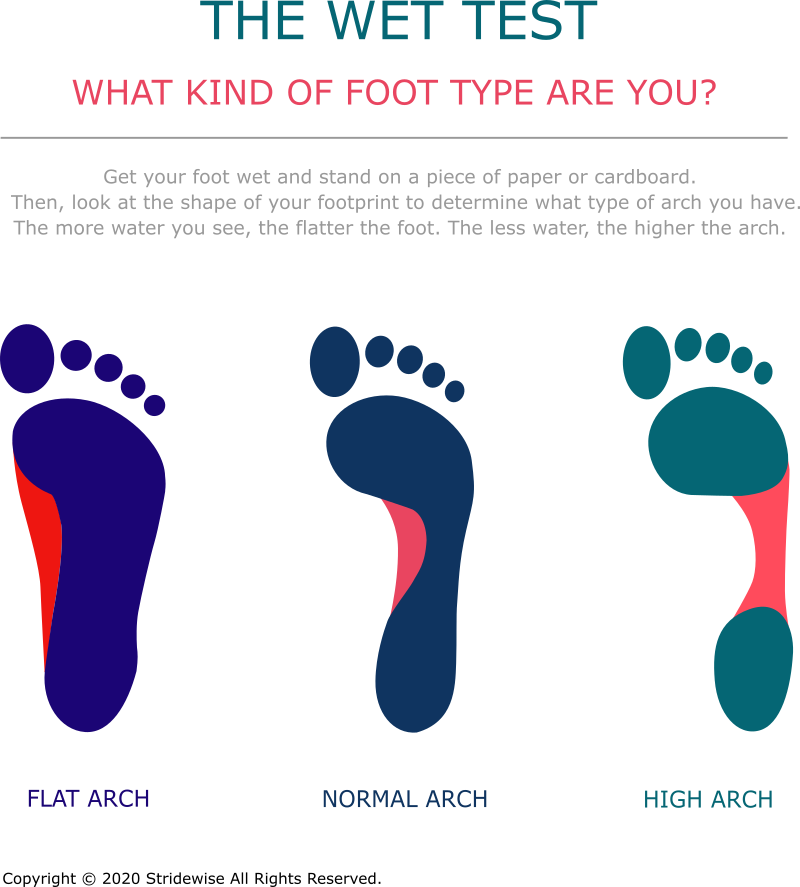
Identify your Arch Type
The next step to finding the best insoles for work boots is to figure what kind of arch you have.
We recommend you do a ‘wet paper test’ to identify your arch type:
- Just take a dry piece of paper or cardboard and place it on the ground.
- Dip the bottom of your foot in water and stand on the dry paper or cardboard placing all of your body weight on it.
- Then check to see how much of your arch touches the paper.
If you have flat feet, you’ll also want to bend your foot and see if an arch forms. If it does, that’s good news and you may just have a low or medium arch. If no arch forms, you might have ridged flat feet, in this case avoid buying insoles with rigid plastic or molded arch support as they will poke into your feet.
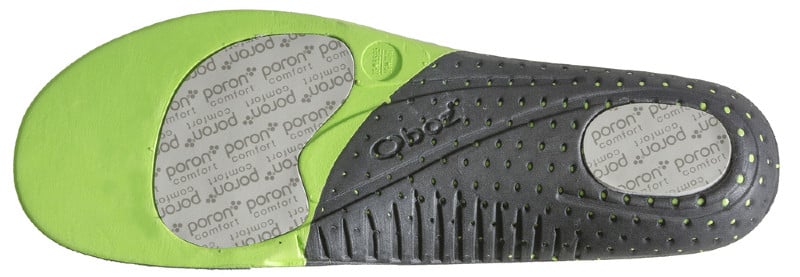
Feet with neutral arches aren’t overly arched nor are they overly flat. If you have neutral arches, look for insoles with structured midsoles and moderate rear-foot stability. You may want insoles with EVA foam or gel like the Oboz Plus Medium Arch Support.
Low arches may contribute to muscle stress and joint problems, but having low arches doesn’t mean you’ll have pain, there may be other factors at play. If you have significantly flat feet, you may benefit from a walking shoe with a straight last and motion control to help stabilize your feet.
High arches may contribute to excessive strain on joints and muscles, as your feet may not absorb shock as well, especially if you carry heavy objects. Look for insoles with cushioning to help with shock absorption. If you have a high arch, they can cause a lot of problems because not much of your foot makes contact with the ground causing instability and knee, back, and joint issues. People need additional support if they have high arches.
[Related: The Best Boots for Flat Feet]
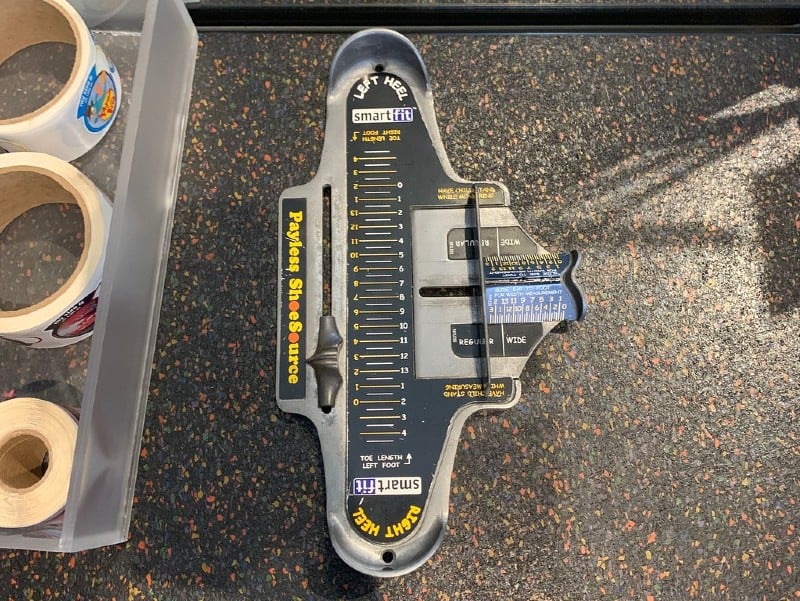

Measure the length and width of your foot
It’s common to see foot problems exacerbated by old, worn out, or poorly fitted shoes. Insoles can cost up to ⅓ of the price of a new pair of boots.
One overlooked option for people with pain in their work boots is fit. Our foot length and width change as we age, and just because a pair of boots fit 20 years ago, doesn’t mean the same brand will fit and perform as well today. If you have pain in your feet, it might be worth it to get a proper fitting at a store.
You can measure your foot at home using this method from White’s Boots. Having worked in the footwear industry, most people don’t really know what size their feet are, a significant number of people have a different sized right and left foot. Insoles can help make boots fit better in this case, but it’s best to have a professional fit your boots.
The Best Insoles for Work Boots
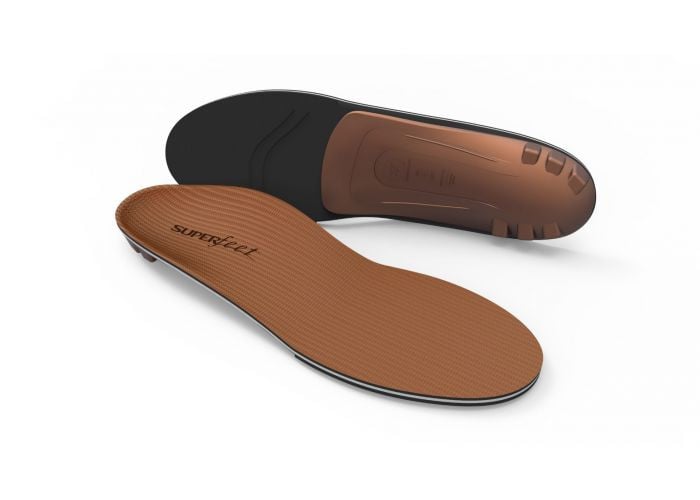

Best Overall: Superfeet Copper Memory Foam ($59.99)
Superfeet is my go-to insole brand for all my shoes, not just work boots.
I’ve worn the Superfeet black because I have flat, rigid arches and suffer from plantar fasciitis. There’s a misconception that flat feet require an insole with a molded arch sometimes people refer to this as “arch support”. A rigid flat footed person will experience discomfort from the plastic bump pressing into their mid foot or arch. A person with a low but flexible arch may want arch support.
Superfeet come in different colors that indicate the arch shape they are designed for. The Blue Superfeet are also good for low or medium arches and people with plantar fasciitis. The classic Green Superfeet are for high-arched people that need additional support for their work boot insoles.


The Copper Superfeet fit a wide range of foot types comfortably. Superfeet’s insoles all have a similar basic construction they have deep heel cup, a structured plastic base that provides additional stability and durability. They also have cushioning in the heel and and forefoot. The cushioning provides stability to reduce joint fatigue and stress. If you’re walking in your work shoes or boots, the cushioning will reduce fatigue.
The Copper Superfeet have all the features of the black and blue models — they have a structured heel cup (A) and stabilizer cap (E) to provide stability. These have a low arch shape (B). They have the same 500 miles or 12 month warranty. In addition, they also added a memory foam layer that molds to your foot (F). The memory foam in the Copper Superfeet provide additional comfort because of the additional cushioning from the foam.
Pros
- Good for low and medium arches
- Structuredm deep heel cup
- Last for 12 months, or 500 miles
- Good shock absorption
Cons
- They are on the expensive side
- Not the best for guys with high arches
- Moderate arch support
Also, they are made for roomy to moderate-fitting footwear, which is common with work boots. If you have a flat or medium arches, these are the best insoles for work boots overall. Basically, these will cover most of your common foot problems.
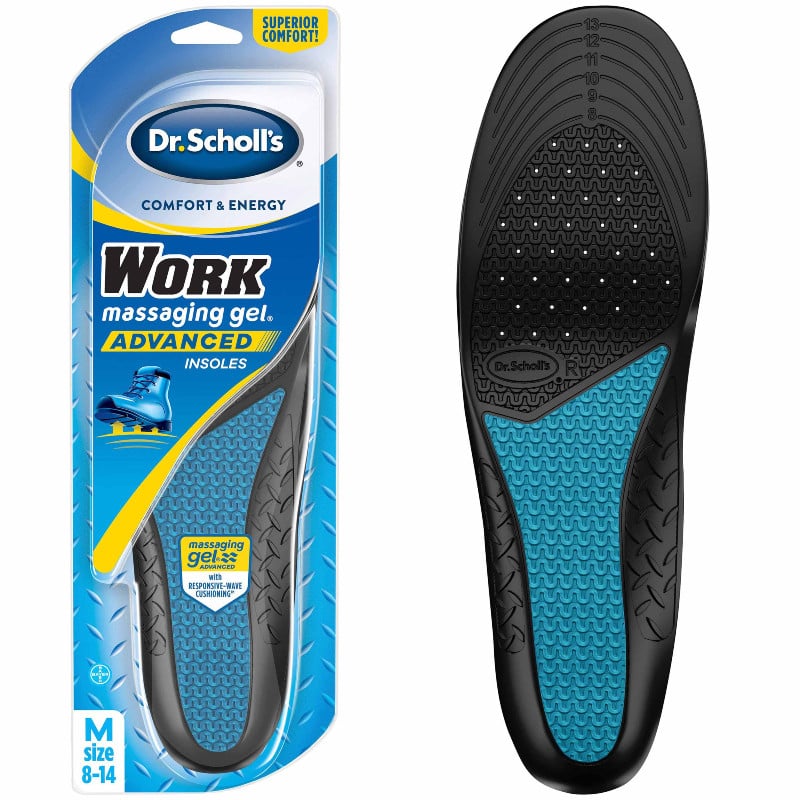

Best Gel Insoles for Work Boots: Dr Scholl’s Work Insoles ($12.99)
There’s a lot to like about Dr. Scholl’s. You can buy them just about anywhere, they’re well priced, and there are a million different types to choose from. We’ve picked the Dr. Scholl’s work insoles as the best gel insoles, because these insoles are designed for work boots.
If you stand or walk on hard surfaces all day, these are very nice. They have extra cushioning from their massaging gel technology that also helps with foot fatigue. They also have “responsive wave cushioning” in the heel, arch, and ball of the foot. These are best insoles for work boots if you need more cushioning. These work well for people who don’t need additional arch support.
Pros
- Inexpensive work boot insoles
- Designed for work boots
- Comfortable massaging gel cushioning, great shock absorption
Cons
- Only comes in one size, but it fits sizes 8-14
- Not the best for guys that have high arches and need work boot insoles
Dr. Scholls has a similar product called extra support insoles for big and tall guys.
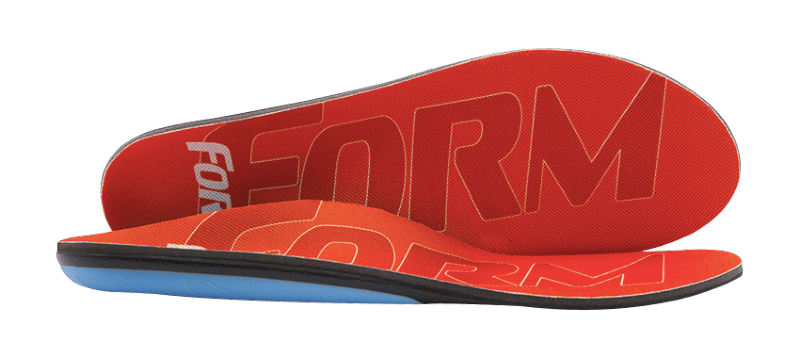

Best Heat Molding: Form Insoles Maximum ($44.95)
Form Insoles are made of a material that forms to your foot as you walk. They are designed for people with plantar fasciitis or anyone who experiences arch pain, heel pain, back pain, or over-pronation. These will mold to your feet as you walk to make sure that your work boot insoles are custom fit to your foot shape. They have some rigid plastic components that may be uncomfortable for guys who were born with rigid flat feet. These may not have enough support for guys with very high arches, but they’re great at shock absorbing.
Pros:
- Heat moldable
- Reinforced with Enduraheel extra support to stop arch and heel pain
- Good for overpronation and low to moderate arches.
Cons:
- On the pricy side
- Not great for high arches
They come in a huge range of sizes from a women’s 5.5 to a men’s 15. They also sell a beefier version called the Reinforced Comfort and Relief insole that is designed for guys over 200 lbs.


Longest Lasting Insole: Tread Labs Pace Boot Insole ($65.00)
Tread Labs was started by Mark Paigen, the man behind Chaco sandals. Tread Labs differs from the other the brands on this list because they are made of two separate, removable pieces: a molded plastic arch for stability and support and an interchangeable top cover for cushioning and shock absorption.
The hard plastic mold has a million mile, or lifetime guarantee. The removable cushion will need to be replaced more frequently.
This molded plastic part can be risky, as some reviewers have said it is uncomfortable. If your foot is too wide for the heel or the arch is too pronounced, that may cause discomfort, like standing on a rock. But, they have a 90-day return policy, so if you don’t like them, you can return them!
The other potential problem with Pace is that they are pretty expensive upfront. Your first pair will cost 65 bucks, but after that replacement top pads are only $16. Compared to the Dr Scholl’s, you get the extra firm, medical-grade structure, where the less expensive insoles don’t have the rigid support.


Pros
- Replaceable components
- You select the arch height when you order, good for people with low to extra-high arches
- Podiatrist-recommended firmness with precision-fit arch support
- Comes with a deep heel cup
Cons
- Expensive
- Not best for people with wide feet, or wide heels
Tread Labs is the only insole company that makes replaceable cushioning and a different molded plastic part for low, medium, high, and extra high insoles. The replacement insole is like a “medical grade orthopedic insole” and provides additional arch support.
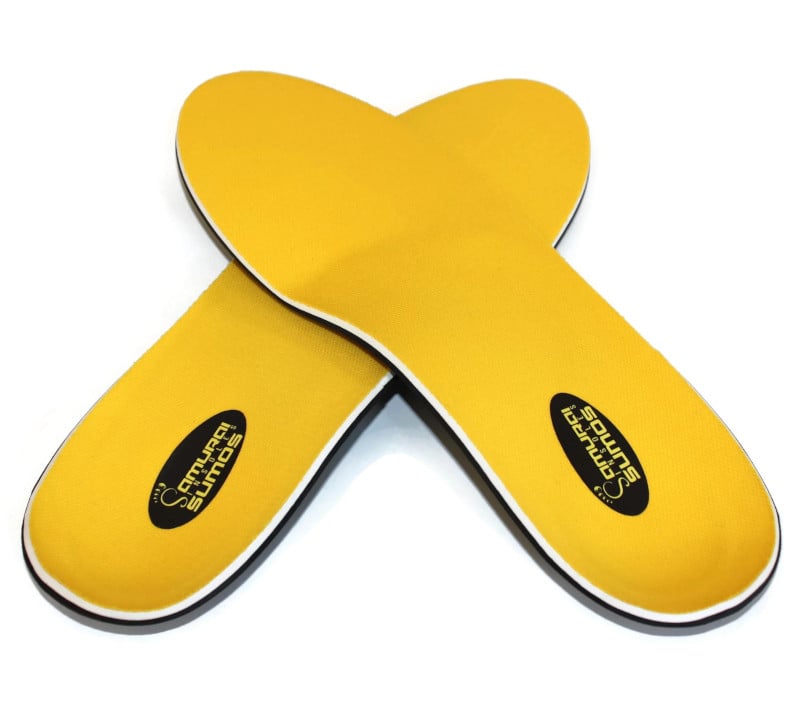

Best for Flat Feet: Sumos by Samurai Insoles Double Padded Orthotics for Flat Feet ($54.00)
Samurai Insoles are designed for roomy shoes like work boots and hiking boots. They have a “Ninja orthotic core,” which is their name for a semi-rigid plastic orthotic placed under the arch, meaning that they flex but provide support at the same time. They added double cushioning, so these are great for people with flat feet who stand or walking for long periods of time.
Pros
- Lightweight, low-profile, and flexible
- Can easily fit in most work boots
- Molds to your feet over time
- Provide comfort and relief from fallen arches
- 60 Day No Risk Test Drive
Cons
- Not the best people with instability from high-arches.
Samurai also makes an insert that you can use with your factory work boot insoles.



Best Insoles for Medium Arch Support: Oboz O Fit Insole Plus Medium Arch ($29.99)
The Oboz O Fit Insole differs from the rest because they use EVA foam and Poron. The Poron Comfort pods provide additional shock absorption and rebound. The Dual-density EVA foam provides both cushioning and durability, and reinforces the foot under the metatarsal and heel. The foam adds extra protection to high-strike zones. EVA and Poron are often used in running shoes and hiking boots to counter the shock experienced while moving, but they can also cushion against the shocks experienced while performing work-related activities.
Pros
- Great for medium arch support
- Great shock absorption from the EVA foam and Poron components
Cons
- Not the best for high arch support
If you are moving a lot in your work boots, these will keep your feet comfy. The EVA foam does a great job at shock absorption. These are the best insoles for medium arch support.
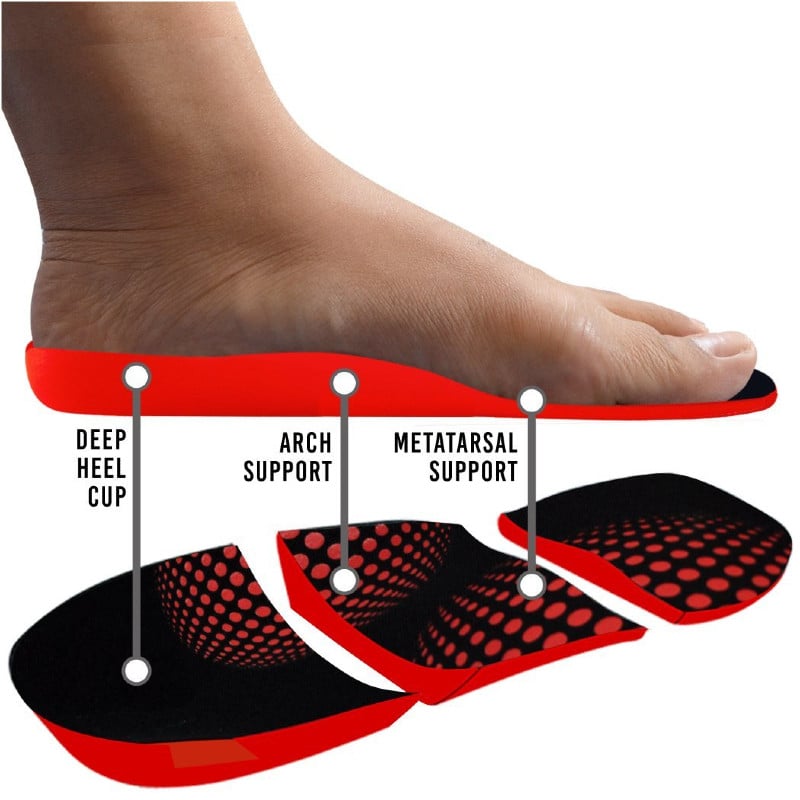

Best For Alignment: Aline Cushion ($109.95)
Aline takes a different approach to insoles: they believe that feet are meant to move as if barefoot. They aren’t specifically made for work boots, but if you’re active at work, these might be worth a try.
They set out to make a radically different design than any other insole the list. They added more than 100 movable support and suspension structures to make your feet and body move as if you were barefoot. They align your feet, legs, hips and back during activity. So if you walk or carry things during work these have a heel cup with gel pads that secure your heel and provides shock absorption.
Pros
- No molded, stiff pieces
- Customizable colors
- Vast range of sizes from 1-15
- Unusually complex design intended to feel as “barefoot” as possible
Cons
- They’re extremely expensive.
One downside is that these are premium insoles and the most expensive on the list.
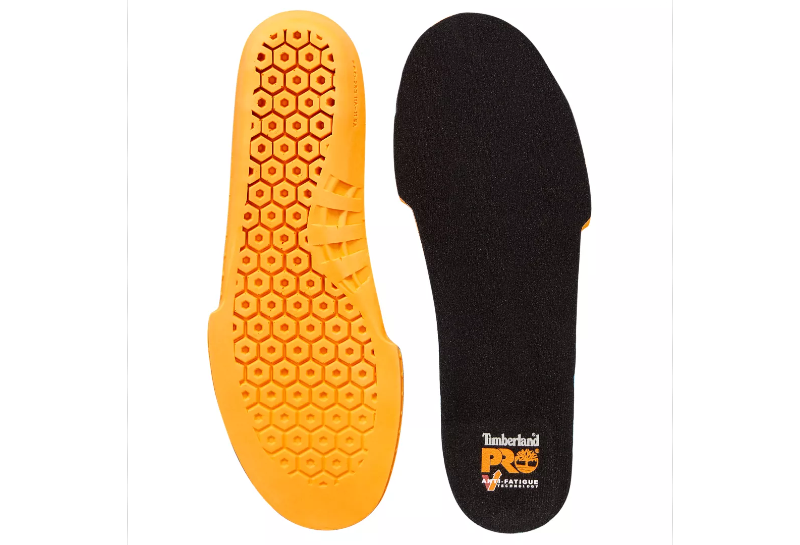

Best Heavy Duty Insole: JobSite Heavy Duty Insoles ($12.99)
The JobSite Heavy Duty insoles are specifically made for work boots. They are best for long-standing on shop floor similar to a personal anti-fatigue mat. The JobSite Heavy Duty insoles are also loaded with cushioning throughout the insole. They also work well for walking. These don’t have any hard plastic pieces, so they’re probably best for low and medium height arches.
Pros
- Shock absorbing with molded arch support for extra comfort and support
- Reinforced metatarsal support for ball of foot comfort
- Deep, high-walled heel cup to stabilize foot
- Extra thick heel cushion to absorb heel shock and give comfort
Cons
- Only come in three sizes, may need a bit of trimming, and won’t work if you have a foot larger than 12.5
- The arch is molded, but they don’t specify which arch height is best suited. Flat and high arched guys, make sure you can return them.
Guys with high arches may want to check out something like SuperFeet or Stride Lab where you can buy a high-arched insole for your feet.
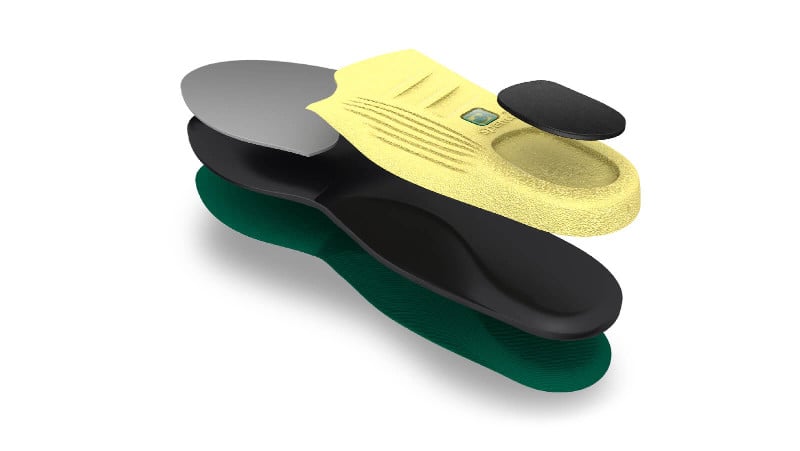

Best Anti Fatigue Insole: Timberland PRO Anti-Fatigue ($30.00)
Timberland makes a highly regarded upgrade to their regular insole called the pro anti-fatigue insole. The Anti-Fatigue Technology Insole features their inverted cone foam, designed to absorb shock and return energy to your feet as you step.
These will make your boots more comfortable for long stretches of work. If you’re standing on cement or hard surfaces throughout the day, the inverted cone foam will help.
Pros:
- Fits men’s sizes 6-15
- No hard plastic molded pieces; if this has been a problem in the past, check these out
- Great price
Cons:
- Not specifically designed for arch support
- Sometimes sold out
You can also check out The MEGAComfort Personal Anti-Fatigue Mat (PAM) Insole from Safegard, recommended by Duke University. They are ergonomic and have a high density memory foam layer. The PAM Insole was designed for industrial footwear with OSHA PPE standards in mind. They are recommended for medium and high arches, they also cost $24.99.


Best Value: Spenco Polysorb Heavy Duty ($24.99)
Spenco is second only to Dr. Scholl’s as one of the most recognized insole brands on the market. They’re popular because they are a great value. and they make no-nonsense insoles that provide ample cushioning.
The Spenco Polysorb Heavy Duty protects against shocks by layering several different densities of materials. They have polyurethane foam, which is found in running shoes, and extra materials in the heel and forefoot to reduce pressure and absorb shocks.
Who Should Wear Spenco Plolysorb Heavy Duty Insoles?
- Larger guys who benefit from the extra cushioning.
- People with rigid flat feet who don’t want molded plastic bits poking their feet.
- Anyone with pain in their heel or forefoot.
Who Shouldn’t Wear Spenco Plysorb Heavy Duty Insoles?
- People who have instability from a high arch. These won’t hurt, but they may not address the underlying causes of your pain.
The Spenco are great if you’re looking for added comfort at a relatively low price. If nothing else works, give these a go.
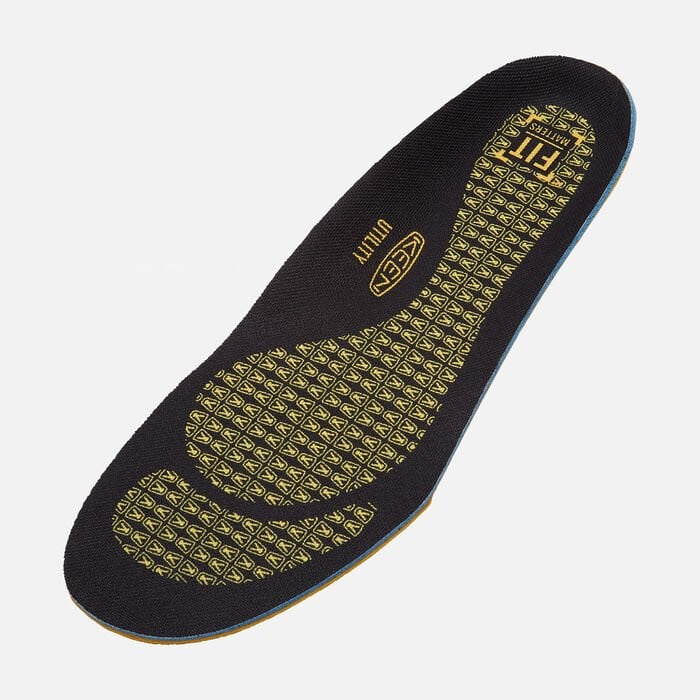

Best for Wide Feet: Powerstep Wide Fit Orthotic Insoles ($39.56)
The Powerstep Wide Fit Insoles are a full-length, semi-rigid orthotic arch support insole. They are the perfect insoles for those with wide width feet. They have a firmer arch support which protects “bottoming out” from excessive weight. They gave an anti-microbial fabric to reduce foot odor and reduces friction on the foot bed. They also have a deep heel cup that stabilizes and cushions the heel during impact. The Powerstep wide also keeps a low profile to limit added volume.
Who Should Buy the Powerstep Wide Fit Orthotic Insoles?
- Anyone with wide feet and neutral arch.
- You want a simi-rigid orthotic, may not be the best for people with rigid arches.
Who Shouldn’t Buy the Powerstep Wide Fit Orthotic Insoles?
- You have flat rigid feet.
- You have high-arches.
If you have wide feet and a high arch, you should check out the WideGreen Superfeet instead.
Best All Day Support and Comfort: Keen Utility K ($25.00)
Keen is famous for making very soft, cushy shoes and boots. Their Keen Utility K insoles are best for guys who need medium arch support. They have shock-absorbing pads and a full-length layer of high-rebound foam to help prevent foot fatigue. They come in a large range of sizes from men’s 6.5 to 14.
These are only made of foam, so they cushion the entire foot with a high rebound foam. The idea for these is that they have plenty of cushioning but the foam won’t compress. While they market themselves as an insole for a medium arch, they also would work for a low arch, if you don’t need arch support. Guys with flat rigid feet should like these as they provide plenty of cushioning and no hard plastic bits.
Who Should Buy the Keen Utility K
- Guys who need a medium arch support and want a lot of cushioning
Who Shouldn’t Buy the Keen Utility K?
- Anyone who has high arches, or who needs additional stability from molded plastic heel cup and arch.
If you want a lot of cushioning and need an insole for high arches check out the Green Superfeet for high arches.
Wrapping it up
Finding the perfect insole can be a real pain. There are just so many factors to take in. From identifying your foot problem to finding insoles that fix the problem and work best for your unique feet.
But once you’ve made sure your work boots aren’t the problem, you’ve identified the problem spots on your feet, you can find work boot insoles that support your feet at work. If you can’t find a pair of work boots or insoles, you may need custom orthotic insoles. Hopefully, this has helped you with your foot related problems.
[Related: My list of The Best Boots for Men]







































![Air gun 101: The differences between .177 & .22 – Which jobs they do best ? [Infographic]](https://airgunmaniac.com/wp-content/uploads/2020/09/g44-150x150.jpg)



